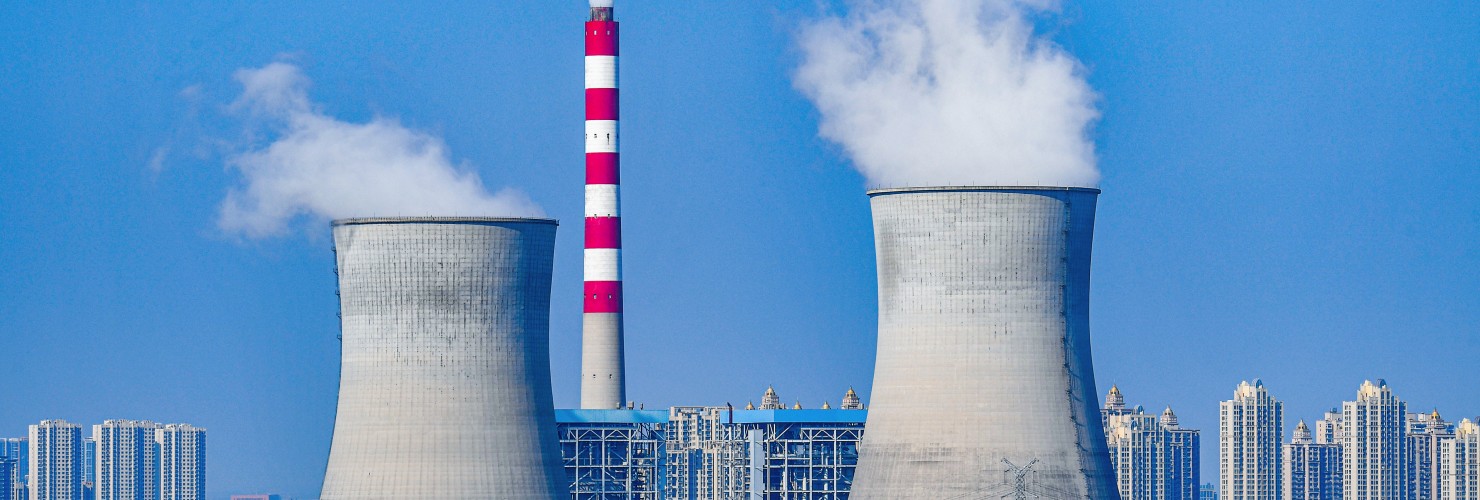

Carbon neutrality plan + Standard setting + Tech upgrades in IoT industry
1. Flagship carbon neutrality plan puts pressure on local officials
At a glance: The Chinese Communist Party Central Committee (CCPCC) and State Council released China’s overarching policy guidelines to peak carbon emissions and reach carbon neutrality. The plan confirms previously announced key targets for 2025 and 2030. The document also establishes a new target to expand non-fossil fuel energy consumption to over 80 percent by 2060. The guidelines cover a wide range of policy initiatives and outline goals such as:
- Drive the green and digital transformation of industries including energy, steel, non-ferrous metals, petrochemicals, building materials, transport and construction
- Accelerate the development of an efficient low-carbon energy system, by strengthening controls over energy intensity and energy consumption
- Promote research into and the application of green technologies
- Improve the legal framework through revisions to the Energy Conservation Law, the Renewable Energy Law, etc., and potentially introduce a specific law on carbon neutrality
MERICS comment: The guidelines form the central pillar of the policy framework, developed by the Leading Small Group on peak carbon emissions and achieving carbon neutrality. On October 26, the State Council further issued the action plan to peak carbon emissions by 2030. Policymakers see this transition as a crucial tool for industrial transformation and upgrading. The government is moving quickly to modernize energy-intensive industries, as they recognize such sectors are low value-added. For instance, the National Development and Reform Commission (NDRC) released energy efficiency plans for the metal, building materials, petrochemicals and chemical industries.
Bureaucrats at all levels of government now need to prioritize cutting emissions. Officials will be assessed by their ability to meet binding targets to peak carbon dioxide and reach carbon neutrality. Additional pressure on local governments is crucial as they ultimately direct the implementation of policy on the ground. It will be up to them to find the right balance. Excessive zeal resulting in risks to energy security, food supply, or disruption to supply chains will also not be tolerated by the central government.
Policy name: Working Guidance for Carbon Dioxide Peaking and Carbon Neutrality in Full and Faithful Implementation of the New Development Philosophy (中共中央 国务院关于完整准确全面贯彻新发展理念做好碳达峰碳中和工作的意见) (Link)
Issuing bodies: CCPCC, State Council
Date: October 24, 2021
China prioritizes green technologies to achieve carbon neutrality and industrial upgrading
Beijing regards green technologies as a strategic opportunity to simultaneously pursue environmental and industrial goals. The guidelines list the following green sectors and technologies as strategic emerging industries to be actively promoted:
- Next generation information technology
- Biotechnology
- Non-fossil fuel energy sources
- New materials
- High-end equipment
- New energy vehicles
- Environmental protection
- Aerospace
- Marine equipment
2. China speeds up standard setting to reap economic and political benefits
At a glance: The CCPCC and the State Council issued the National Standardization Development Outline. The 15-year plan builds on previous standardization reforms that have improved business participation in standard setting. China says it wants a more market-driven standardization system but is unwilling to let go of government guidance. By 2025, the government aims to:
- Revise national standards so that 85 percent or more match international standards [no details regarding the exact calculation of conversion]
- Speed up the development timeframe of standards from 24 months to under 18 months
- Improve access for foreign-invested companies in domestic standard setting
MERICS comment: Standardization is a key part of China’s innovation-driven development strategy. China wants scientific breakthroughs to quickly translate into commercial gains and standards. Domestic firms stand to benefit through increased royalty fees and avoid the costly adaption of rival standards. As such, Beijing would rather not leave this process up to chance or market mechanisms.
While leading in areas like 5G and ICT, China still lags behind other advanced economies when it comes to standardization. Only 1.8 percent of international standards are Chinese. Beijing wants to promote standards in specific areas like biotech and AI, as well as industries such as high-speed rail, new energy vehicles and robotics. Multinational companies (MNCs) in these sectors can expect more Chinese funding for basic research, economic competition and standard proposals.
If measures are enforced, MNCs could benefit from greater access to China’s market. In recent years, China has adopted national rather than international standards, a non-tariff barrier that China was able to get away with due to its market size. Now, Chinese firms are eyeing global markets. The ambitious conversion rate target of 85 percent (up from 24 percent in 2019 and 35 percent in 2010) indicates that China aims to avoid decoupling in standard setting, which could create costly lock-in effects and hurt Chinese firms overseas. Legally, MNCs are already equal participants in domestic standard setting. In practice, however, they still face substantial barriers, such as access to information or voting rights.
Policy name: The Central Committee of the Communist Party of China and the State Council issued the "National Standardization Development Program" (中共中央 国务院印发《国家标准化发展纲要》) (Link)
Issuing bodies: CCPCC, State Council
Date: October 10, 2021
3. Beijing eyes tech upgrades in booming Internet of Things industry
At a glance: Eight central government agencies, led by the Ministry of Industry and Information Technology (MIIT), released a three-year plan for the construction of Internet of Things (IoT) infrastructure. The policy defines IoT as sensor and communications technology connecting people, machines and objects, which can offer services in the form of information sensing, transmission and processing. The following are listed as key goals for 2023:
- Advance the level and market competitiveness of key technologies such as high-end sensors, IoT chips, IoT operating systems and new short-range communications
- Promote the growth of 10 leading IoT enterprises, each with revenue of over CNY 10 billion and able to spur on the development of IoT SMEs
- Improve the IoT standard system, revise over 40 national or industry standards
MERICS comment: IoT technology falls under the scope of “new infrastructure” such as 5G, 6G, IPv6, big data, etc. China hopes to develop a competitive edge in these areas to accelerate the country’s modernization, boost innovation and productivity, as well as counter the looming challenges of an aging population and rising wages.
Drawing on China’s position as an electronics manufacturing hub, as well as its strong consumer demand, China’s IoT industry has developed in leaps and bounds. It has been estimated that China’s IoT connections account for 30 percent of the global total. Alibaba, Huawei, Xiaomi and Baidu have all rolled out large-scale consumer IoT platforms.
Chinese firms have also established numerous collaboration projects with European firms on IoT technology. Such cooperation is crucial for China's IoT enterprises as many still rely on foreign technology in key areas. Officials are most interested in developing local capacities in areas such as intelligent sensing technologies for multiple sources and massive data access, MEMS sensors and IoT operating systems. Foreign businesses will continue to play an important supplier role as the industry expands.
Policy name: Notice on Issuing the "Three-year Action Plan for the Construction of New Internet of Things Infrastructure (2021-2023)" (关于印发《物联网新型基础设施建设三年行动计划(2021—2023年)》的通知) (Link)
Issuing bodies: MIIT, CAC, MOST, MEE, MOHURD, MOA, NHC, NEA
Date: September 29, 2021
4. Tighter regulation of algorithms poses potential risks for foreign firms
At a glance: Nine agencies, including the Cyberspace Administration of China and MIIT, published an outline for regulating internet services algorithms. The ministries plan to establish a comprehensive algorithm security governance system by 2023 and propose the following measures:
- Formulate policies that outline the rights of users and responsibility of companies regarding algorithm security governance
- Construct a multi-dimensional, integrated supervision system (including algorithm security risk monitoring and security assessment)
- Establish a standardized algorithm ecosystem, whereby algorithms promote CCP values and priorities, and their application is fair and just as well as secure and controllable
MERICS comment: Increasing government control over the digital economy and data is a global phenomenon. In China, after the Cybersecurity Law came into effect in 2016 the government accelerated its control. Now, it’s moving faster than other jurisdictions by increasing the scope of regulation to algorithms, which are a set of instructions to accomplish a given task, like a search query. Algorithms and their applications, for instance in AI, have strategic relevance for China’s economy and society. Beijing is now signaling that it is not willing to let companies independently decide how they are used.
The guidelines make clear that companies will be held accountable for the outcomes of their algorithms. This could cause a litany of compliance and liability issues which could affect airlines, manufacturing companies or carmakers. Companies developing autonomous vehicles could find themselves liable for accidents caused by their cars. In addition, there is also the risk of politicization. But it may be the case that authorities use their growing control over algorithms to favor indigenous brands over foreign ones, particularly if the Chinese leadership attempt to exert economic coercion on a particular country.
Policy name: Guiding Opinions on Strengthening the Comprehensive Management of Internet Information Service Algorithms (关于印发《关于加强互联网信息服务算法综合治理的指导意见》的通知) (Link)
Issuing bodies: CAC, CCPCPD, MOE, MOST, MIIT, MPS, MCT, SAMR, NRTA
Date: September 29, 2021
5. Data security categories for industrial sectors remain unclear
At a glance: MIIT issued measures to regulate data security in industry and information technologies sectors. The draft supplements the Data Security Law (DSL), which requires enterprises to classify their data, and is the first sector-specific plan providing more details on this process. The draft:
- Classifies data as low risk “ordinary data,” high risk “important data,” or very high risk “core data” according to the degree of potential harm to individuals, the economy or national security which could be caused by damages or leaks
- Obliges companies to adopt data protection measures, as per the DSL, such as data security training or contingency plans for data security incidents
- Clarifies that data on biological, space, polar and deep-sea activity and artificial intelligence is either important or core data
MERICS comment: The measures are part of China’s drive to increase data regulation to reduce data abuse, monopolistic behavior and promote data as a production factor to fuel economic growth. Despite providing new details, the draft’s classification definitions are vague and therefore not very helpful. In its current form, the regulations provide ample room for authorities to independently decide how data ought to be classified. This leaves the data protection system open to rule by, not of, law.
Since the passing of the Cybersecurity Law, companies have known that the cross-border transfer of certain types of data would be difficult. The draft clarifies that for “core data” any transfer will be completely banned. For data classified as “important” a security review will be necessary. This could render some company activities in China, including R&D, obsolete or require companies to decouple their China operations from their global ones. The recording and reporting requirements will also increase compliance costs. Nonetheless, the draft indicates that China, while strictly regulating data, remains supportive of companies using it for economic activities.
Policy name: Measures for the Administration of Data Security in the Field of Industry and Information Technology (Draft for Comments) (公开征求对《工业和信息化领域数据安全管理办法(试行)(征求意见稿)》的意见) (Link)
Issuing body: MIIT
Date: September 29, 2021
WORTH NOTING
Policy news
- September 29: The Ministry of Transport issues a five-year new infrastructure plan that aims to develop smart road, air and shipping transport (MOT notice (CN))
- September 30: MIIT releases a list of 987 pilot projects trialing the use of 5G in medical care, including the specific application, affiliated institution and location (MIIT notice (CN))
- October 8: The NDRC and Ministry of Commerce release the 2021 edition of the market entry negative list for public consultation (NDRC notice (CN))
- October 20: The MIIT solicits opinions on new energy vehicle safety system instructions (MIIT notice (CN))
- October 21: The CCPCC and the State Council issue the Outline of the Construction Plan for the Chengdu-Chongqing Economic Circle (State Council notice (CN); South China Morning Post article (EN))
- October 22: The Ministry of Commerce releases the Five-Year Plan for Utilizing Foreign Investment, announcing that China will further open up (MOFCOM notice (CN); South China Morning Post article (EN))
- October 26: The Ministry of Finance releases a notice instructing local governments to treat domestic and foreign enterprises equally in government procurement (MOF notice (CN); Caixin article (EN))
Corporate news
- September 29: Continental and fabless AI chip developer Horizon Robotics sign a joint venture (JV) agreement for advanced driver assistance systems and autonomous driving (Continental press release (EN))
- October 11: AstraZeneca opens its R&D center in Shanghai’s Jing’an district (Shanghai government notice (EN))
- October 12: CATL reveals plans to build a USD 5 billion battery material recycling facility in Hubei and form a JV with Hubei Yihua Chemical Industry (Reuters article (EN))
- October 19: Ericsson announces that it will reduce its China operations after suffering a big drop in sales (Reuters article (EN))
- October 21: Daimler opens its CNY 1.1 billion R&D center in Beijing to accelerate local product development (Daimler press release (EN))
- October 24: Three state-owned rare-earths producers will merge their subsidiaries to create a company with a nearly 70 percent share of China’s production quota for medium and heavy rare earths (Nikkei Asia article (EN))

